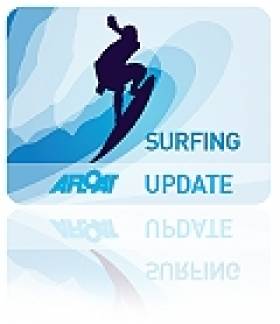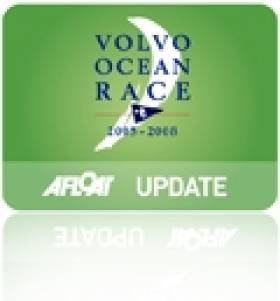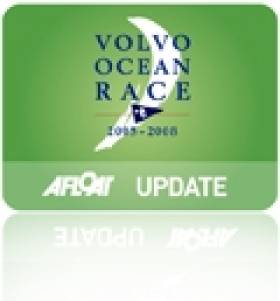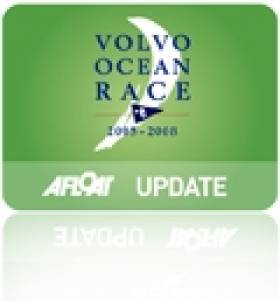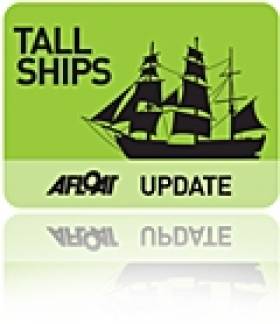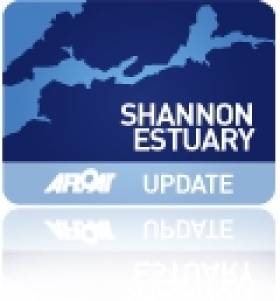Displaying items by tag: Brazil
Brazilian Tall Ship Strikes Bridge in Ecuador
A tall ship from Brazil left onlookers breathless when it collided with a pedestrian bridge over a river in Ecuador on Monday (18 October).
As reported by Marine Industry News, the Brazilian naval training vessel Cisne Branco (White Swan) had been visiting the city of Guayaquil for a number of days before it drifted into the bridge in what appears to be a strong current and listed heavily on its port side.
The Amsterdam-built ship was righted to even keel with the help of tugs — but in the process one of the tugs was capsized. No injuries were reported among the crews of either vessels.
CNN Brazil carried a video report of the incident which can be viewed below:
Ireland's Hall Knocks Out World Surfing Champ At Rio Pro
#Surfing - Irish surfer Glenn Hall pipped reigning ASP world champion Joel Parkinson for a place in the quarter-finals of the Billabong Rio Pro this week, as Australia's SBS News reports.
Thirty-one-year-old Hall - who was born in New South Wales but has dual citizenship thanks to his Irish grandfather - did not survive much longer himself in the competition at Barra da Tijuca in Brazil, being eliminated in the fifth round by South Africa's Jordy Smith.
But the ASP world tour rookie surprised many with his third-round knockout of the current world champ, who went board-to-board with 11-time champion Kelly Slater for the title last year.
Newport Makes It Six For VOR 2014-15 Host Ports
#VOR - Newport in Rhode Island has been announced as the latest stopover for the next edition of the Volvo Ocean Race in 2014-15.
The popular sailing base in the 'Ocean State' will be the North American port on the race route for its 12th running as the end point of the leg from Itajaí in Brazil, and is hosting the event for the first time.
"It's about time the race came to the city of Newport and we are looking forward to a real festival that will delight and inspire sailing fans and those who are new to the sport," said Volvo Ocean Race CEO Knut Frostad at the announcement.
Conveniently located between the Irish-American hotspots of New York City and Boston, the crowds in attendance are sure to feature a prominent 'green' element.
As reported at the weekend on Afloat.ie, Gothenburg in Sweden has been awarded the honour of hosting the VOR finale, much to the disappointment of Galwegians after last summer's successful event.
Brazil Now A Double Host for 2014-15 Volvo Ocean Race
#VOR - Brazil will now have two stops on the route for the 12th edition of the Volvo Ocean Race as Itajaí joins the previously announced Recife on the list of host ports.
Itajaí, in the state of Santa Catarina, staged a memorable stopover in the 2011-12 edition with huge crowds packing the Race Village throughout, and the port’s return to the route means the south of Brazil is joining the north east in the race.
As previously reported on Afloat.ie, a boat backed by the state of Pernambuco was confirmed at last week’s announcement which race organisers say will ensure a distinct Brazilian flavour for the race's 12th edition in 2014-15, at a time when the focus of world sport will be on the country.
"Making two stops in Brazil makes perfect sense at a time when the country will be the beating heart of sport between soccer's World Cup in 2014 and the Rio Olympic Games in 2016," said Volvo Ocean Race CEO Knut Frostad.
"We are thrilled to be going back to Itajaí, which proved to be one of the most successful stopovers of the last edition with a rhythm all of its own.
"We had huge numbers of fans in attendance on all the key dates and with the support of the city and the region we're looking forward to breaking those records next time."
Once again, Itajaí will provide the long awaited finish line for the teams following their rounding of the iconic Cape Horn in the Southern Ocean.
"The leg through the Southern Ocean, around Cape Horn and on to Brazil, was an instant classic in the last edition," said Volvo Ocean Race COO Tom Touber, who made the announcement at the Castelo Montemar in Itajaí today (22 January).
"Going twice now to the vast, diverse and sports-mad country of Brazil is a privilege for us."
Speaking at the announcement, Itajaí mayor Jandir Bellini added: "Hosting the Volvo Ocean Race once again is proof that Itajaí is capable of staging the biggest events in the world.
"It is our goal to confirm Itajaí as a national capital of sailing."
Exact dates of the Itajaí stopover will be announced next month. The remainder of the route for the 12th edition of the Volvo Ocean race will be revealed over the coming weeks.
Volvo Ocean Race Returns to Brazil for 2014-15
#VOR - Organisers of the Volvo Ocean Race have announced that the Brazilian state of Pernambuco will enter a team in the next edition of the round-the-world offshore challenge in 2014-15.
In addition, its capital city of Recife will be the first stopover port along the race route, which starts in Alicante in the second half of next year.
The Recife team is only the second publicly announced team for the 12th edition of the VOR, following the SCA all-women's team announced last August.
Details about the stopover and the team, including the identity of the skipper, will be announced in the coming weeks.
“[The] announcement of the Pernambuco team and Recife stopover are fantastic news for the race,” said Volvo Ocean Race CEO Knut Frostad. “I’m delighted to see the Race strengthen our ties with Brazil, Recife and Pernambuco in this way.
"Coming to Recife at the end of Leg 1 means there will be a lot of attention on this great city and having a Brazilian team in the race will be fantastic for fans across the country."
The decision to make Leg 1 of the route from Alicante to Recife means the VOR will be visiting Brazil in one of the biggest sporting eras in the nation's history – just a few months after the country hosts the 2014 Fifa World Cup and less than two years before the Olympic Games in Rio.
Recife was one of over 80 ports to express an interest in hosting the race when the bid process was launched in 2012. The deal announced yesterday will see Recife host the race for the next two editions.
The last Brazilian team to enter the Volvo Ocean Race was Brasil 1 in 2005-06. Torben Grael was the skipper and Knut Frostad, now the Volvo Ocean Race's CEO, featured as a crew member on some of the legs. The Brazilian campaign proved to be a big success and generated great interest worldwide and in the media. Grael went on to win the Volvo Ocean Race as skipper of Ericsson 4 in 2008-09.
The Volvo Ocean Race's links with Brazil date back to 1973, when the first edition of what was then known as the Whitbread Round the World Race stopped at Rio de Janeiro.
The race also visited Rio in the second edition in 1977-78 and again in 2001-02, 2005-06 and 2008-09. In 1997-98 the race stopped at São Sebastião and in the last edition in 2011-12, Itajaí was a host port.
Meanwhile, Team SCA have unveiled the livery for their VOR 65 new design when it is launched and ready to race later this year.
As previously reported on Afloat.ie, the new design VOR 65 - priced at €4.5 million, about 20% less expensive than the 70-footer that ended its run in Galway last summer - was developed with the idea of reducing the costs of competing in the gruelling round-the-world yacht race.
The official VOR website has images of the SCA livery, with nature-inspired graphics and colours designed to reflect the eco-friendly values of the title sponsor, global hygiene company SCA.
At the beginning of February, a number of Team SCA women crew candidates will leave Southampton on a first test sail together with several leading off-shore coaches.
Team SCA have not yet revealed the identity of any of the crew, including the skipper.
Groupama Try Out a New Watch System
#VOLVO OCEAN RACE - Has the Groupama sailing team adopted a new simplified watch system, keeping just one man on deck to handle the vessel - as demonstrated by Ireland's Damian Foxall in the video above?
Don't worry - it's just a prank for April Fool's Day yesterday!
The yacht and its full compliment of crew have rounded Cape Horn and are currently in overall second place as the Volvo Ocean Race fleet heads to Itajaí in Brazil on the fifth leg and longest passage of the race.
Groupama and PUMA are currently battling for first place on the leg, with Telefónica hot on their heels after making up 180 miles in just 36 hours with speeds near double those of the frontrunners.
Safety of World's Tall Ships In Question
Safety on the world's 700 sail training tall ships has been called into doubt, Sail World reports.
The concern comes following an investigation into the sinking of Canadian tall ship Concordia off the coast of Brazil last year.
The ship capsized in a squall on 17 February 2010. All 64 passengers and crew spent two days adrift in lifeboats before being rescued.
Investigators from the Transportation Safety Board of Canada concluded last week that no action was taken to prevent capsizing, such as reducing sail or changing course, because the officer-in-charge did not realise the ship was in danger.
The board also learned that the officer-in-charge was able to get his certification without having to familiarise himself with information on the handling and stability of the ship, and found that this lack of a requirement is universal across the world's sail training vessels.
Senior investigator Paulo Ekkebus said this was "a large concern" and called for stricter standards worldwide.
He added: "We’ve not been able to find any country, any flag-state, requiring the study, or for people that they are familiar with this type of information, if it is provided on board the ship."
Sail World has much more on the story HERE.
Alliance Franҫcaise de Cork and Fondation Belém in association with the Port of Cork are pleased to announce arrival of the French tall-ship fleet, Belém, a 116-year old barque at one stage owned by the Guinness family, writes Jehan Ashmore.
During her four-day stay the pride of the French tall-ship fleet is to berth at Albert Quay, in the heart of Cork city-centre where the public can thread her timber decks on Saturday (2 July) between 11.30-17.00 hours and on Sunday (3 July) starting from 10.00 till 18.00 hours. There is an admission of €5 for adults, a concession of €3 and a family ticket costs €10.
Visitors can trace her long and varied career with an exhibit housed below decks of the historic vessel which was built in 1896 in Nantes. For nearly two decades she crossed the Atlantic transporting a diverse cargo but mostly spices, sugar and cocoa beans from her namesake port of Belém do Pará, on the north-east coast of Brazil bound for France. She would sail upriver on the River Seine to supply the cocoa beans for a Paris-based chocolate-maker.
Belem would later become under the British flag and she became the property of the Duke of Westminster, who converted her to a luxury pleasure yacht. In 1921 she was sold to the Hon. Arthur Ernest Guinness, who renamed her Fantôme II and took part in the Cowes regattas and cruised around the world between 1923 and 1924 with his family.
To read more on the vessel's other career's under several owners until her present-day role as a sail-training vessel operated by the Fondation Belém click HERE and also www.portofcork.ie
In addition to visitors boarding the Belem, the public are invited to attend free readings by the Cork poets William Wall and Thomas McCarthy. Accompanying the poets are French writers Maylis de Kerangal and Olivier Sebban for a session of Franco-Irish readings which too takes place on the Saturday evening between 18.00 -19.30 hours.
For further information contact Vytenė Laučytė, Cultural Coordinator, Alliance Franҫaise de Cork Tel: (021) 431 0677 or by email: [email protected]
All advance bookings for the visit on board the Belem are to be made at Alliance Franҫaise de Cork. Tickets are also available at the entrance to the tallship alongside Albert Quay, Cork. Last year Alliance Francaise celebrated its 50th anniversary
- Cork Harbour
- port of Cork
- Brazil
- Alliance Française
- Cork Harbour News
- Paris
- Belem
- Arthur Ernest Guinness
- Cocoa
- TallShips
- Albert Quay Cork
- Fondation Belem
- Tall Ships news
- Duke of Westminster
- Guinness
- Paris chocolate makers
- Fantome II
- William Wall
- Thomas McCarthy
- Cork poets
- French writers
- Maylis de Kerangal
- Olivier Sebban
Bulker Becomes Largest Vessel to dock at Foynes
The 61,000 dwt bulker Sibulk Prosperity became the largest ship to date to dock at Shannon Foynes recently according to The Limerick Leader.
The Panamanian registered vessel carrying a cargo from Santo in Brazil. At 200 meters long and a draft of 10.5 meters, the vessel delivered a cargo of 22,000 tonnes and took 3 days to discharge its cargo of animal feed. The discharge rate was 1,100 per hour for her time in port. Limerick based ship agents Mullock & Sons provided stevedoring services.
Tim Egan, manager of Mullocks & Sons Shipbroking in Foynes said 'Ships that usually come into Foynes would be about 35,000 dwt. This is almost double that but the challenge isn't her size but her length. The way they are building ships these days, it nearly double the dead weight but is the same depth in the water. She will have to turn around in the Estuary to get out when she leave the port'.
Mr Egan commented that 'two years ago the Port Company of Shannon Foynes invested in a dredging vessel which has allowed super-sized cargo ships to get in and out of the port with greater ease. The dredging and ploughing has kept a depth in the Channel which makes it a lot easier'.
The Sibulk Properity departed Foynes with the assistance of Celtic Tugs based in Foynes.


























